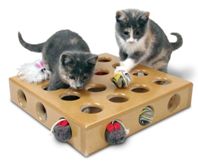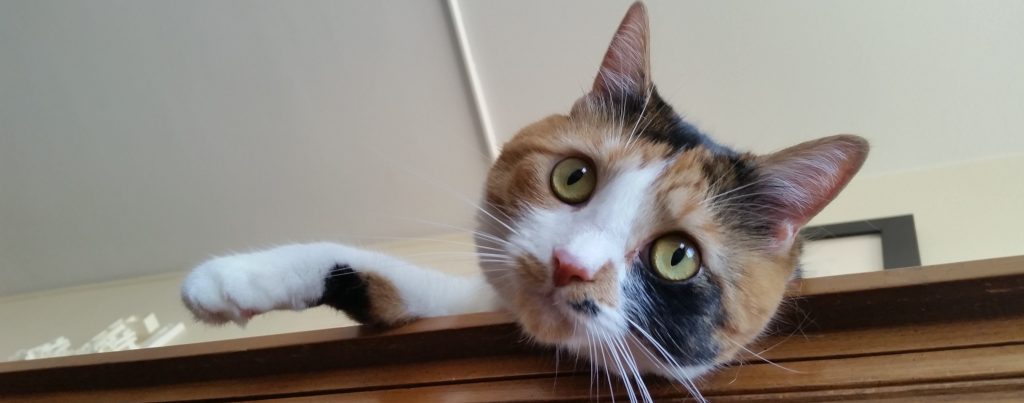MyThreeCats.com was named an expert in a Rent.com article. Check out the featured article: 4 Tips For Choosing Cat-Friendly Holiday Decorations| Rent.
Rent is a subsidiary of Redfin.com
Category: kitten care
Vet Trips Made Easier
 Amy D. Shojai is a certified animal behavior consultant and the award-winning author of 23 pet care books, including “Complete Kitten Care” and “Pet Care in the New Century: Cutting-Edge Medicine for Dogs & Cats.” View more about Amy by clicking here:
Amy D. Shojai is a certified animal behavior consultant and the award-winning author of 23 pet care books, including “Complete Kitten Care” and “Pet Care in the New Century: Cutting-Edge Medicine for Dogs & Cats.” View more about Amy by clicking here:
https://www.thesprucepets.com/amy-shojai-cabc-551736
________________________________________
Cats get the short end of the health care stick. According to the American Veterinary Medical Association, cats visit the vet much less frequently than dogs. It’s not that felines are healthier (although cats do hide illness better) but many cats hate the vet so much their owners find it easier to just skip it. But even healthy cats need well exams once or twice a year.
Cats are adept at protecting themselves from stranger danger. What’s familiar is safe, while anything new or different raises kitty suspicions. A vet visit delivers a triple whammy by changing the cat’s routine, environment and exposure to strangers. Here are seven reasons cats hate the vet and how you can ease the angst.
Negative Crate Expectations. Cats learn very quickly to recognize cause and effect. The appearance of the cat carrier prompts kitty disappearing acts if used only for vet visits. Make the carrier part of the furniture and add a fuzzy bed or catnip toys inside to create a pleasant association.
Claustrophobic Car Rides. Though humans can look out windows and know what’s happening, the cat’s-eye view from the carrier offers movement without warning. Odd sounds and being in a strange environment raise cat blood pressure and might even prompt motion sickness. Covering the view with a towel over the carrier’s door helps some cats. But simply taking Kitty for many short rides around the neighborhood (and never going to the vet!) followed by treats or games can diminish nerves.
Scary Smells. Cats experience much of life through their noses. The array of unfamiliar smells found in a hospital — antiseptic, strangers, other animal’s fear — can ramp up the kitty fright factor. A pheromone product like Comfort Zone with Feliway that can be spritzed on a towel inside the carrier can help soothe environmental stress.
Strange Pets. Nothing turns felines into hiss-terical claw monsters like barking dogs or meowing cats. When confined inside a carrier, your frightened cat can’t flee, so the fight-or-flight instinct has no outlet. She may redirect her fear aggression on the nearest target — you or the vet staff. Ask to schedule your cat’s exam early in the morning or at slow times to avoid a busy waiting room. Some vet practices have separate waiting rooms and entrances for cats and dogs, so at least your cat never has to see or hear the mortal enemy.
Cold Exam Tables. Though cats may hate getting into their carriers, being dumped on a cold metal table elevates the “strangeness” of the experience significantly. After all, Kitty-Boy’s preferred lounging spots are the windowsill with a view, the soft top of the sofa, or a table underneath a warm lamp. Take along a towel or even the cat’s bed that smells like your cat to make the exam table more feline friendly. Some cat specialty practices have exam room windows with bird feeders outside or water fountains and fish tanks for kitty distraction.
Weird People Doing Weird Things. The vet and clinic staff love animals, but to your cat they’re from Mars. Maybe they wear uniforms and smell like dogs (spit!) and don’t ask permission to stroke his fur. A particular stressor is being handled by several people — the vet tech for getting a temperature or stool sample, for example, and later the veterinarian. Reducing the number of handlers may help. Scheduling enough time so the cat doesn’t feel rushed also can ease the tension.
Painful or Surprising Events. Needle sticks aren’t much fun. And a cold thermometer inserted into the nether regions is no way to make friends. It’s up to owners to offer treats or toys during and immediately after upsetting procedures to help change how cats feel about vet visits.
Cats remember discomfort, fear and bad experiences and expect them in the future. But they also remember good experiences and anticipate accordingly. Ask about taking your kitten for “fun visits” to meet and get used to the vet and staff, so he can simply play and be petted rather than examined and treated. Repeated happy visits take the scary out of the equation. Make vet visits more pleasant, and your cat will be happier — and healthier.
“Happy Cats are Healthy Cats”
Lynn Baer, DVM, Cat Specialist, shares her top tips for cat owners to ensure well adjusted, happy cats. Lynn says, “happy cats are healthy cats and happy cats make owners happier and healthier, too”.
Tip #1) Recognize the fact that indoor only cats have no choices of their own in life.
They are completely reliant on what we offer them. We choose their litter box size, shape, location and litter substrate. We choose where they are fed, what they are fed out of, and what foods they are offered. We choose their toys, their beds, their bowls, and everything within their lives. Cats have few choices of their own. They would be happier given more choices of their own and once owners understand that and begin to expand their options, cats would remain healthier and happier.
Tip #2) Bring the outdoors in
Cats are held captive within four walls for their entire lives. Open the blinds, open the windows, grow grass, bring leaves and branches in for them to smell. Again for owners to be more aware of the fact that their cats have never walked on grass or soil, experienced changes in temperature, smelled different smells, or had the ability to walk around the block to explore new surroundings. Owners should evaluate every opportunity to enhance their indoors cat’s lives by bringing new things into the home. Build catios, window units or other alternative opportunities for cats to experience the outdoors. At a minimum place window seats around the house (off the ground), build vertical spaces for them to climb, train them to walk on leashes, erect cat proof fences, etc.
Tip #3) Play, play, play and more play
Indoor cats are bored, depressed and inactive. Owners don’t generally play with their cats daily. Cats need exercise, mental stimulation and fun. Having a basket of toys for cats is not enough. Owners should actively engage with their pets by using wand toys, laser lights, throwing blankets over furniture to create tents, rotating toys daily. Adding silvervine, catnip, and valerian to their arsenal of toys will give cats new experiences. Using foraging toys for food rewards, making cats hunt for some of their food all help to stimulate their body and mind.
Tip #4) Lots of scratch posts – both vertical and horizontal for cats to scratch on.
I am completely opposed to declawing (having never performed one in my entire career). Scratching is a form of communication and also gives cats the ability to stretch their muscles. It is important they have great areas and substrates to scratch on. It makes them happy.
Tip #5) Seek out cat only veterinarians
Don’t allow a veterinarian who declaws to treat your cat. Take your cat to a vet at least once a year for a good physical exam and blood work. Cats are notorious for hiding pain and illness and if an owner thinks their cat is sick, they are likely very sick. Pay attention to any changes (no matter how small) and seek veterinary care immediately. Age is not a disease and many owners ignore signs of illness as due to advanced aging. That is not in a cat’s best interest. Owners need to advocate on behalf of their pets and insure good medical care. Seek second opinions. Good veterinarians encourage owners to do so and are never offended by it.
Tip #6) Cats need wet food more than dry
Wet food is lower in calories and higher in protein and moisture. It is extremely important to feed cats at least 5-6 times daily. Don’t feed one brand or diet only. Variety is the spice of life and cats are used to eating birds, squirrels, rats, mice, chipmunks, bugs, etc. One diet or one brand is not normal. Either is feeding once or twice a day.
Source: The Purrington Post
Editors Note: Find many of the toys, scratchers, outdoor enclosures and cat furniture mentioned in this article right here.
Miraculous Story – Frozen Kitten Saved by Man With CPR
A small, white kitten camouflaged by freshly fallen snow, was discovered frozen by the Bingham children playing outdoors.
The seemingly lifeless kitten was rushed inside their house. A quick thinking father called his vet trained brother, Justin, who rushed to the scene and started to work on the motionless kitten.
After Justin dedicated an hour of rubbing the kitten and pumping his chest in an effort to get his blood flowing (see video at: Lazarus Kitty ), the miracle baby started to revive. By the end of the day, the little guy was up on his paws and meowing.
The family named him Lazarus, after the Bible story of Lazarus, whom Jesus raised from the dead. Lazarus was adopted into the family, and is now romping energetically around their home.
Miracles do happen!

What types of environmental enhancements do you offer your cat?
Caring for cats properly involves much more than simply furnishing food, water and a litter box. Environmental enrichment, such as toys, food puzzles, perches, and even hiding places, can really change the quality of life for almost any cat.
The Winn Feline Foundation recently took a look at this issue in a group of shelter cats on their blog. Environmental enrichment in shelter cats is an excerpt from a study which provided a food puzzle to a stable group of shelter cats and examined their reaction to the puzzle and their interactions surrounding the object. The study concluded:
“a stimulating item that can be shared by all individuals in a stable group, such as a puzzle feeder of appropriate size, can play an important role in promoting positive social interactions among cats and improving their welfare.”
Certainly, in shelter cats, this is an important study. It underlines the need for more than just basic care in the lives of these animals and the fact that this enrichment is easily achievable. After all, the ultimate goal is to give these cats the best chance for adoption. Cats that are comfortable in their environment and confident will show it in their behavior. And confident behavior is much more “adoptable” than a cat that is hiding in his cage or, worse yet, acting in aggressive manner out of fear.
However, this study also can be extended to those of us who keep multi-cat households. I have three cats and frequently see two or more of my cats interacting with the toys and puzzles at once. In fact, it seems as though if one cat shows interest, it generates interest in the other cats as well.
Many environmental enhancement toys, cat furniture and other items can be found at www.MyThreeCats.com, the experts in optimum care care and well being.

